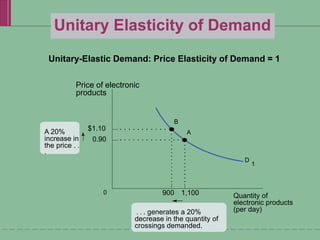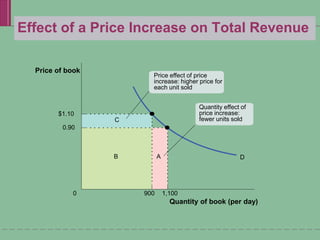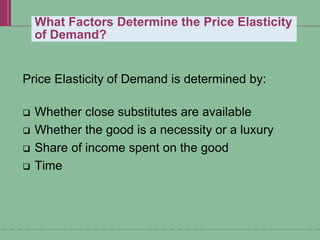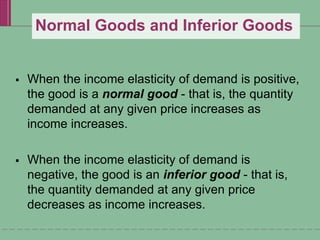Elastisitas.ppt
- 1. ELASTISITAS Program Studi Pendidikan Ekonomi Fakultas Ekonomi Universitas Negeri Yogyakarta Daru Wahyuni
- 2. Apa pengertian elastisitas permintaan ? price elasticity of demand income elasticity of demand price elasticity of supply Apa faktor yang mempengaruhi nilai elastisitas permintaan? Bagaimana hubungan antara elastisitas dan total revenue. Apa pengertian elastisitas penawaran ? Apa faktor yang mempengaruhi nilai elastisitas penawaran? Pertanyaan Penting
- 3. Price elasticity of demand: angka yang mengukur persentase perubahan jumlah barang yang diminta karena adanya perubahan harga sebesar 1 persen. Pengertian Elastisitas Permintaan
- 4. D 10.0 9.9 $21 20 Price of vaccination A 0 Quantity of vaccinations (millions) B Demand for Vaccinations When price rises to $21 per barrel, world demand falls to 9.9 million barrels per day (point B).
- 5. Calculating the Price Elasticity of Demand
- 6. Using the Midpoint Method The midpoint method is a technique for calculating the percent change. In this approach, we calculate changes in a variable compared with the average, or midpoint, of the starting and final values.
- 7. Using the Midpoint Method
- 8. Using the Midpoint Method
- 9. Some Estimated Price Elasticities of Demand Good Price elasticity Inelastic demand Eggs 0.1 Beef 0.4 Stationery 0.5 Gasoline 0.5 Elastic demand Housing 1.2 Restaurant meals 2.3 Airline travel 2.4 Foreign travel 4.1 Price elasticity of demand < 1 Price elasticity of demand > 1
- 10. Interpreting the Price Elasticity of Demand Two Extreme Cases of Price Elasticity of Demand: Demand is perfectly inelastic when the quantity demanded does not respond at all to changes in the price. When demand is perfectly inelastic, the demand curve is a vertical line. Demand is perfectly elastic when any price increase will cause the quantity demanded to drop to zero. When demand is perfectly elastic, the demand curve is a horizontal line.
- 11. Two Extreme Cases of Price Elasticity of Demand (a) Perfectly Inelastic Demand: Price Elasticity of Demand = 0 1 0 Quantity of shoelaces (billions of pairs per year) $3 $2 Price of shoelaces (per pair) … leaves the quantity demanded unchanged. An increase in price… D1
- 12. Two Extreme Cases of Price Elasticity of Demand (b) Price Elastic Demand: Price Elasticity of Demand = ∞ At any price above $5, quantity demanded is zero At exactly $5, consumers will buy any quantity At any price below $5, quantity demanded is infinite 0 $5 Price of pink tennis balls (per dozen) D 2 Quantity of tennis balls (dozens per year)
- 13. Interpreting the Price Elasticity of Demand Demand is elastic if the price elasticity of demand is greater than 1. Demand is inelastic if the price elasticity of demand is less than 1. Demand is unit-elastic if the price elasticity of demand is exactly 1.
- 14. Unitary-Elastic Demand: Price Elasticity of Demand = 1 900 1,100 B A 0 $1.10 0.90 Price of electronic products A 20% increase in the price . . . D 1 . . . generates a 20% decrease in the quantity of crossings demanded. Quantity of electronic products (per day) Unitary Elasticity of Demand
- 15. Inelastic Demand: Price Elasticity of Demand = 0.5 950 1,050 B A 0 $1.10 0.90 D 2 Price of beef A 20% increase in the price . . . . . . generates a 10% decrease in the quantity of beef demanded. Quantity of beef (per day) Inelastic Demand
- 16. Elastic Demand: Price Elasticity of Demand = 2 … generates a 40% decrease in the quantity of luxuarydemanded. 800 1,200 B A 0 $1.10 0.90 Quantity of luxuary(per day) D 3 Price of luxuary A 20% increase in the price . . . Elastic Demand
- 17. Why Does It Matter Whether Demand is Unitary-Elastic, Inelastic, or Elastic? Because this classification predicts how changes in the price of a good will affect the total revenue earned by producers from the sale of that good. The total revenue is defined as the total value of sales of a good or service, i.e. Total Revenue = Price × Quantity Sold
- 18. Total Revenue by Area 1,100 0 $0.90 Price of book D Total revenue = price x quantity = $990 Quantity of book (per day)
- 19. Elasticity and Total Revenue When a seller raises the price of a good, there are two countervailing effects in action (except in the rare case of a good with perfectly elastic or perfectly inelastic demand): A price effect: After a price increase, each unit sold sells at a higher price, which tends to raise revenue. A quantity effect: After a price increase, fewer units are sold, which tends to lower revenue.
- 20. Effect of a Price Increase on Total Revenue B A C Price effect of price increase: higher price for each unit sold 900 1,100 0 $1.10 0.90 Quantity of book (per day) Price of book D Quantity effect of price increase: fewer units sold
- 21. Elasticity and Total Revenue If demand for a good is elastic (the price elasticity of demand is greater than 1), an increase in price reduces total revenue. In this case, the quantity effect is stronger than the price effect. If demand for a good is inelastic (the price elasticity of demand is less than 1), a higher price increases total revenue. In this case, the price effect is stronger than the quantity effect.
- 22. Elasticity and Total Revenue If demand for a good is unit-elastic (the price elasticity of demand is 1), an increase in price does not change total revenue. In this case, the sales effect and the price effect exactly offset each other.
- 23. Demand Schedule and Total Revenue D 0 0 1 2 3 4 5 6 7 10 9 8 $25 24 21 16 9 Quantity Total revenue 0 1 2 3 4 5 6 7 10 9 8 $10 9 8 7 6 5 4 3 2 1 Quantity Price Demand is elastic: a higher price reduces total revenue Elastic Inelastic Unit-elastic Demand is inelastic: a higher price increases total revenue $0 1 2 3 4 5 6 7 8 9 10 $0 9 16 21 24 25 24 21 16 9 0 10 9 8 7 6 5 4 3 2 1 0 Total Revenue Quantity demanded Demand Schedule and Total Revenue for a Linear Demand Curve Price The price elasticity of demand changes along the demand curve
- 24. What Factors Determine the Price Elasticity of Demand? Price Elasticity of Demand is determined by: Whether close substitutes are available Whether the good is a necessity or a luxury Share of income spent on the good Time
- 25. Other Demand Elasticities: Cross-Price Elasticity The cross-price elasticity of demand between two goods measures the effect of the change in one good’s price on the quantity demanded of the other good. It is equal to the percent change in the quantity demanded of one good divided by the percent change in the other good’s price. The Cross-Price Elasticity of Demand between Goods A and B
- 26. Cross-Price Elasticity Goods are substitutes when the cross-price elasticity of demand is positive. Goods are complements when the cross- price elasticity of demand is negative.
- 27. The Income Elasticity of Demand The income elasticity of demand is the percent change in the quantity of a good demanded when a consumer’s income changes divided by the percent change in the consumer’s income.
- 28. Normal Goods and Inferior Goods When the income elasticity of demand is positive, the good is a normal good - that is, the quantity demanded at any given price increases as income increases. When the income elasticity of demand is negative, the good is an inferior good - that is, the quantity demanded at any given price decreases as income increases.
- 29. Measuring the Price Elasticity of Supply The price elasticity of supply is a measure of the responsiveness of the quantity of a good supplied to the price of that good. It is the ratio of the percent change in the quantity supplied to the percent change in the price as we move along the supply curve.
- 30. Two Extreme Cases of Price Elasticity of Supply (a) Perfectly Inelastic Supply: Price Elasticity of Supply = 0 100 0 Quantity of cell phone frequencies $3,000 2,000 Price of cell phone frequency S1 … leaves the quantity supplied unchanged An increase in price… (b) Perfectly Elastic Supply: Price Elasticity of Supply = ∞ 0 Quantity of pizzas $12 Price of pizza S2 At any price above $12, quantity supplied is infinite. At exactly $12, producers will produce any quantity At any price below $12, quantity supplied is zero.
- 31. Two Extreme Cases of Price Elasticity of Supply There is perfectly inelastic supply when the price elasticity of supply is zero, so that changes in the price of the good have no effect on the quantity supplied. A perfectly inelastic supply curve is a vertical line. There is perfectly elastic supply when even a tiny increase or reduction in the price will lead to very large changes in the quantity supplied, so that the price elasticity of supply is infinite. A perfectly elastic supply curve is a horizontal line.
- 32. What Factors Determine the Price Elasticity of Supply? The Availability of Inputs: The price elasticity of supply tends to be large when inputs are readily available and can be shifted into and out of production at a relatively low cost. It tends to be small when inputs are difficult to obtain. Time: The price elasticity of supply tends to grow larger as producers have more time to respond to a price change. This means that the long-run price elasticity of supply is often higher than the short-run elasticity.
- 33. TERIMA KASIH Program Studi Pendidikan Ekonomi Fakultas Ekonomi Universitas Negeri Yogyakarta
Editor's Notes
- #31: Figure Caption: Figure 6-6: Panel (a) shows a perfectly inelastic supply curve, which is a vertical line. The price elasticity of supply is zero: the quantity supplied is always the same, regardless of price. Panel (b) shows a perfectly elastic supply curve, which is a horizontal line. At a price of $12, producers will supply any quantity, but they will supply none at a price below $12. If price rises above $12, they will supply an extremely large quantity.
































